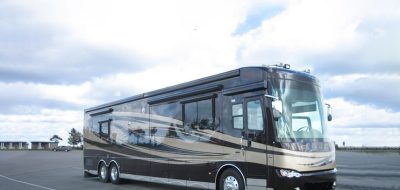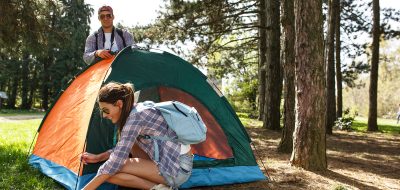 My main troubleshooting philosophy has always been that in order to figure out what is wrong with an appliance or system, you need to understand how it works. Over the next few months, I’ll try to cover
My main troubleshooting philosophy has always been that in order to figure out what is wrong with an appliance or system, you need to understand how it works. Over the next few months, I’ll try to cover
LP Appliances in RVs all- with the exception of the stove top burners- have some sort of flame detection and safety circuit, which senses whether a flame is burning, and shuts off the flow of gas if it isn’t. Through the years, there have been 4 major types of systems- all of which are still in use.
The major types are:
- Mechanical
- Thermo-electric
- Thermo-electric hybrid
- Pure electronic (a.k.a. DSI)
Today I will concentrate on the thermo-electric type, which , which uses a pilot flame and a thermocouple….
 In new RVs, the major appliance which uses a pilot/thermocouple safety system is the water heater- though some new LP ovens use them as do some of the smaller refrigerators. In the past LP furnaces used this type of system as well, but most of those have reached the end of their useful life.This type of safety system can be recognized by the fact that you always have to push, pull, or turn something and hold for a bit after you light the pilot (or flame)
In new RVs, the major appliance which uses a pilot/thermocouple safety system is the water heater- though some new LP ovens use them as do some of the smaller refrigerators. In the past LP furnaces used this type of system as well, but most of those have reached the end of their useful life.This type of safety system can be recognized by the fact that you always have to push, pull, or turn something and hold for a bit after you light the pilot (or flame)
The thermo-electric pilot type system has 3 major parts- the pilot burner (picture), the Thermocouple (picture), and the Gas valve/Thermostat.
The thermocouple is a device which- in this application- produces a very small electric current when heated by the pilot flame. This current is used to hold open a safety valve, allowing the LP gas to flow to the pilot and main burner.
In this picture (click to enlarge), I am heating the end of a thermocouple with a small flame, I have the meter set on millivolts and have it hooked to the output end of the thermocouple. The flame is quite small (it’s there though- trust me), but the thermocouple is still putting out over 10 millivots. Normal output is between 15 and 30 millivolts. A side note- older furnaces would use what is called a thermopile, which is basically a bunch of thermocouples put together to produce enough current to actually operate a valve- and not simply hold one open as the thermocouple does in this use.
A point I want to bring up here is that the end of the thermocouple that screws in to the gas valve is actually an electrical connection- Notice the insulator between the very tip end and the outer “ground” shield. Over tightening this connection can crush the insulator and short out the voltage produced by the thermocouple, keeping it from holding the safety valve open. Standard procedure is to tighten finger tight plus 1/4 turn, adding 1/8 turn if needed.
Being an electrical connection, oxidation on the tip can also influence performance (this happens a lot on older Dometic refrigerators- more on that later).
The last part of this system is the safety valve, which on a water heater is inside the gas valve/thermostat.  This valve has a small magnet and coil inside which uses the small current produced by the thermocouple to hold a valve (the plunger in this picture) open- once you have opened it by pushing, pulling or turning something.
This valve has a small magnet and coil inside which uses the small current produced by the thermocouple to hold a valve (the plunger in this picture) open- once you have opened it by pushing, pulling or turning something.
So- the basic requirements for this system to work are:
- A large enough pilot flame to heat the end of the thermocouple
- A thermocouple which is producing a large enough current to hold the safety valve open.
- A complete circuit between the thermocouple and the safety valve (more on this later)
- A safety valve which is operational.
Once you know how the system is designed to work, and what each part does, troubleshooting a fault becomes much easier.
Next week, I’ll take this knowledge and use it to show the common failures in the typical water heater, and how to fix them.
Questions or comments? Post them in the RV.Net Forums in this thread








mike dodge
Hi,
I have a 1970 airstream which has been giving me fits with the propane appliances,either i am not getting enough volume/pressure to begin with or can not maintain enough fuel to keep things going tying into the stove supply line shows 11″ but by the second burner it drops to around 8-9 by the 3rd burner ti drops to three. w/heater would never adjust to any thing but a fluttering flame back into the shutter slide [which at one point almost cost me the trailer!]the heater’s pilot would stay lit for 5-10 min then go out,but the nordic seemed to work fine as did the propane lamp.so i blew out all flue intakes and exhaust’s blew the gas lines out as well.installed new control valve thermocouple/pilot on the water heater and works fine for about5-10 then shuts off.. while rebuilding the hheater i have replaced the regulator at the bottle replaced any lines i felt might have been just a little to kinkned or kinks which which might effect volume/pressure. which one would yOu recommend on increasing first volume or psi which i am convinced one of which is the problem.
‘
Washer & Dryer Repair Service
I do not evеn understanԁ how I ended
up here, however I thought thіs submit was goοd.
I don’t realize who you are however definitely you are going to a famous blogger in the event you aren’t alгеady.
Cheers!
James Henley
the lp tank on my leftside of camper doesnt work for some reason .The tank is full and have tried different tank .I think it might be the auto switch over valve,This camper is 2 yrs old but have never run low enough on lp touse the other tank
Stephen Dover
Hello Chris,
My brother Ben thinks you are full of it but likes your photo, he has a diploma in gas diagnosis witch he only got to pull the chicks, and the rest of the time he has his hand on it.
Keep up the good work and remember its all about you my son and maybe the coroner.
Chris Bryant
Hi Stephen,
I’m not sure why I’m not under “Authors” any more (I’m probably not posting enough ;)), but my brief bio is still at my about page, but briefly, I’m master certified by the RVIA (and have been for over 10 years), and have factory training by pretty much every major applicance maker- Atwood, Suburban, Norcold, Dometic, etc.
–Chris
Stephen Dover
Hello Chris,
Are you qualified to give technical information and advise on gas appliance?
And if so I do not see your qualifications listed.
May god be with you my son.
Kind Regards Stephen Dover
Scott Sherman
Hi Chris. I appreciate the information you have provided.
My situation involves an older furnace . . . a Mission furnace from a 1952 Airstream.
I have replaced the regulator, control valve and am installing a thermopilot shut-off valve to make sure that when the pilot light goes out the propane is shut-off. The interesting situation is that the control valve has an electrical connection that goes to the pilot light and the thermopilot has a heat sensative tubing or thermocouple.
Which do I use?
Do I need a new pilot light?
Any suggestions you might have for me would be appreciated.
It would probably be nice to get a new furnace but all of the other appliances are original and are working fine.
karen
Hello, I have a 1975 Fleetwing. I know its old. Up until today, the hot water heat was working. Its made by American Appliance Mfg. Corp in Santa Monica California. Serial number 55205. I dont even know if they are still in existence. Anyway, The pilot lights and when you release the ?(push down button) to turn the dial to the “ON” position, the flame goes out. Any ideas? Thanks
Dennis
Could you advise me what the problem that I have recently encountered could be. I have an older model Mor-Flo ARV-6 water heater that up until this weeken , has functioned properly. Last Friday, I ignited the pilot light and then turned the heater on. All worked fine until the middle of the night when it was discovered that the heater was off. I re-light the pilot light then turn the heater back on. In the morning, again the unit was off. I light the pilot light but this time the heater would not ignite. After a few tries, there was a small flame burning on the heater, not the stronger one that heats the unit. The propane tanks are 3/4 full. What is the problem?
Pkunk
An interesting discovery! I was removing the bed platform in preparation for replacing the limit switch in the rear furnace when I saw a vent hose running down to the basement. I couldn’t see where it went so started exploring. After about 30 min. of peering into compartments & removing panels I found that it was a heated basement & the hose had been terminated straight down against the floor so that no air could exit. I repositioned the hose, anchored in place with a screw and washer and replaced the limit switch. The furnace now runs normally & I have a heated basement!
Clark
You did a fantastic job. This article is simple and easy to follow the instruction. (it would be nice if IRS would do the same on publication 17. Ha) Looking forward to read more article from you again.
Pkunk
Chris, thanks! I ordered new limit switches & installed the one in the front furnace. I couldn’t find any blockages & it runs normally now. The only thing that comes to mind is when I had it repaired In St. George, it was on a Sat. & maybe the proper switch wasn’t installed. Next, I’ll investigate replacing the one in the back furnace. Should be fun!
Chris Bryant
It would not be a good idea (in fact- it would be a very, very bad idea).
There is some reason why the unit is overheating, and that reason need to be discovered and fixed. Running with the hi limit switch disabled could cause a number of problems, from a cracked heat exchanger to a fire.
Pkunk
That’s what I thought it was, just at the time couldn’t think of a name. All the ducting is good, airflow is excellent, and no other apparent problems. How dangerous would it be to just leave a jumper in place?
Chris Bryant
Hi Pkunk,
That sounds like a temperature limit switch. They usually are not that failure prone, and there are a few things which might cause them to go bad, but I would look at air flow and ducting first- make sure all of the ducting is hooked up, and all of the registers are open.
Pkunk
Gas furnace has a relay/ elec switch which has gone bad on both units. Had one replaced & it cr**ped out in a few days. It looks like a reset button but isn’t, is round in a square sheet metal mount & has 2 wires. I can jumper & make the furnace work, but what causes this “safety device” to burn up so quickly? The second furnace is in the rear bedroom & in order to pull the heater to repair it requires removing the bed & watertank. I’m not enthusiastic to do it more then once.
Dave T
Thanks Chris and Casey…..I’ll clean ‘er up and see what happens! Thanks for the great info!!!!
Casey Balvert
Chris, great article. I will look forward to your future offerings. Casey
Casey Balvert
I have had the same problem with my fireplace. Cleaning the connections on the back of the switch fixed the problem.
Casey
Chris Bryant
Hi Dave,
Thats a tough one…. just because I’m not familiar with gas fireplaces, but…
A couple of thoughts- if the pilot will stay burning, the thermocouple is probably fine, but it depends on what actually opens the gas valve, which could be operated by 12 or 24 volt power, a mercury bulb operating a thermostatic valve, or it could be a thermopile, millivolt system, in which case the thermopile could be getting weak- still strong enough to keep the pilot burning, but not enough to open the valve.
But… this is all guess work on my part :).
Dave T
Great so far, and timely as I am having a problem with a gas fireplace….maybe you can clarify for me. I have a pilot light and it appears to be the same size and shape as in the past…which has always been sufficient to operate the fireplace. For some reason now, the fireplace will not turn on when the switch is thrown…..where do I look to resolve the problem?